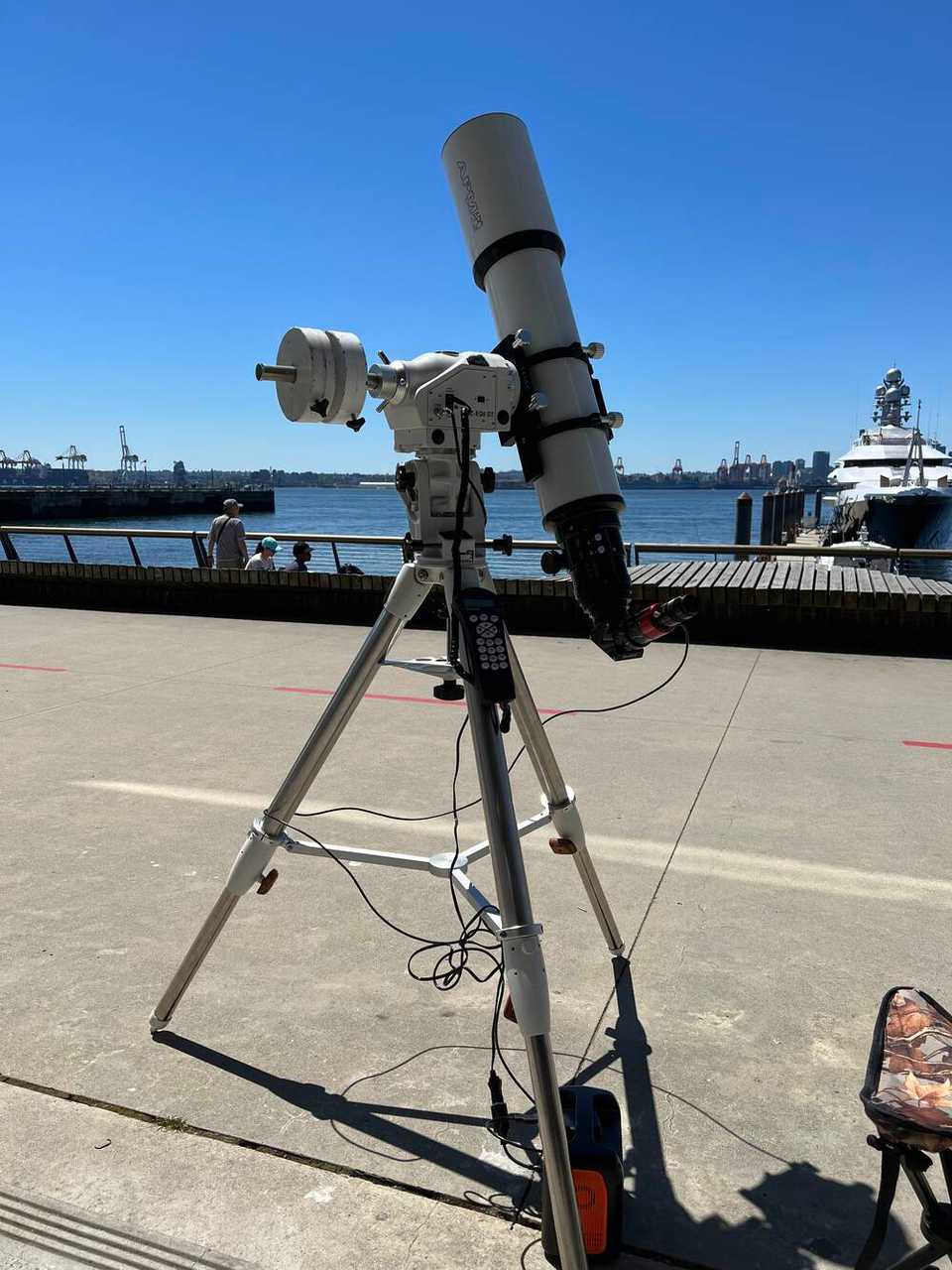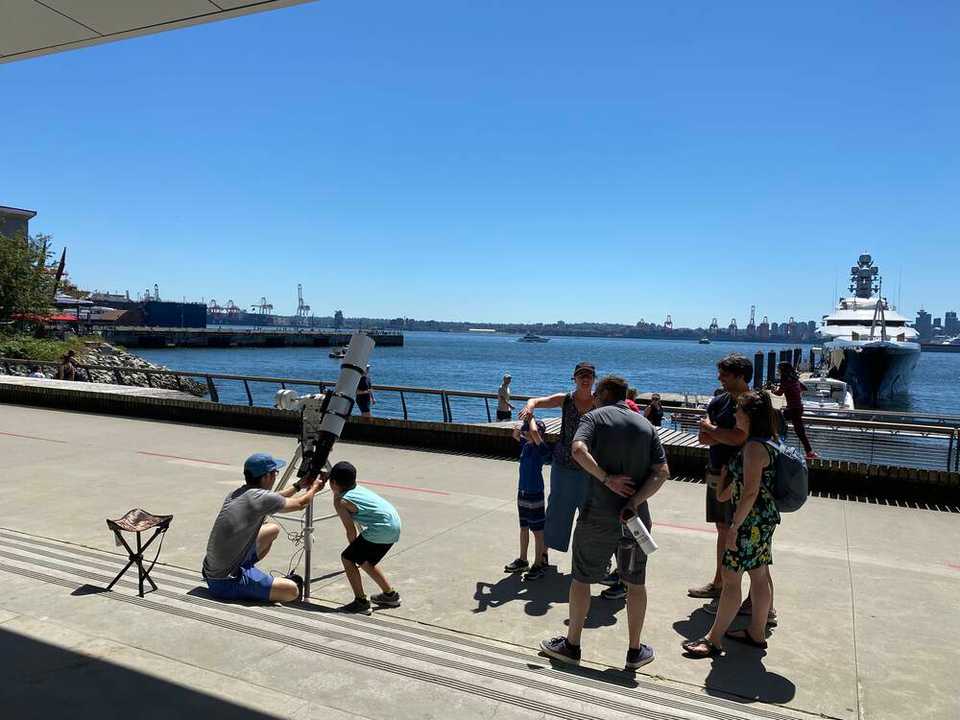Solar Outreach
As goodness stands in the intelligible realm to intelligence and the things we know, so the sun stands in the visible realm to sight and the things we see.
— Plato, The Republic VI (508c)
It was the clearest of days on Sunday, June 26, and possibly the hottest day so far in the year, with highs of 32 degrees Celcius. After being thoroughly impressed by the planetary performance of the APM 140 the prior morning at the Cypress Lookout, I wanted to see what it could do when combined with the Daystar Quark h-alpha filter.
Since the Daystar has a built-in 4.2x Barlow, turning the 980mm focal length of the APM 140 into a monstrous 4116mm, I decided to bring my AZ-EQ6 so that I wouldn’t have to worry about tracking the sun manually.
Maria met me while I was pulling my wagon filled with gear, looking for a place to set up. We decided that behind the Polygon Art Gallery was an ideal location because it has a shaded area so we could cool off - it was starting to get very hot indeed!

I mounted the scope and went through the initialization, adding in the geolocation, elevation, date, and time. Then I slewed the scope to the rough location of the sun manually, as I had no stars to do the 2-star alignment. Finding the sun turned out to be a major challenge; the 32mm eyepiece combined with the 4100mm+ focal length of the telescope yields a 128x magnification, and due to the small field of view of the Plossl eyepiece, I struggled for over half an hour to locate the sun, slewing back and forth and sweating buckets.
In hindsight, instead of slewing, I should have loosened the clutches and manually navigated around to locate the sun, as I’ve done in the past using the Stellarvue M2C mount. I had previously disabled the dual encoders in the mount since for night observing I’ve not found the need to manually move the mount, and I read that disabling the encoders improves go-to accuracy.
Needless to say, I was greatly relieved when the red ball of nuclear fire slewed into my eyepiece and struck by the amount of detail I could see in the chromosphere, as well as the massive prominences jutting out with authority out of the solar disk. It was magnificent. I told Maria to have a look; I’m sure she was as relieved as I was that I hadn’t set up this massive instrument in vain. She too was impressed by the detail, telling me that the prominences looked like wispy clouds, and by this time some curious people were starting to gather, asking what we were looking at.

I’ve learned that solar observing with the Daystar Quark is much more challenging for inexperienced observers than lunar or planetary observing. First, the stray daylight at the eyepiece significantly reduces contrast, making it difficult to view fine detail. I show people how to cup their observing eye with one hand, in effect extending the eyecup of the eyepiece. Second, I am limited to using simple Plossl eyepieces with the Daystar, as exotic wide-angle eyepieces simply don’t work well due to technical reasons. Due to the built-in Barlow, the already generous eye relief of the 32mm Plossl extends a significant amount past the eyecup, making eye placement all the more finicky, while also introducing the stray daylight I mentioned earlier. Lastly, people find it challenging to achieve focus if they remove their glasses due to the relatively low contrast nature of h-alpha viewing.
I’m confident that the first two challenges are resolvable by investing in a solar hood to create shade and a Televue 32mm Plossl with eyecup extensions. Since the scope and Daystar are owned by the UBC Astronomy Club, I’ll suggest that we acquire this equipment.
Despite these challenges, I invited anyone interested to view through the eyepiece, having carefully framed a sunspot and the largest, most impressive prominences I could find. Maria and I did our best to walk them through the process and explain what they should be able to see. It usually takes adults some time to position their eye correctly to see the view, but most can get a good glimpse of the chromosphere and prominences.
All of this coaching is more work compared to lunar or planetary outreach, where I can set everything up and have people look without much input from me, but it was gratifying for both myself and Maria when we succeeded in helping people see the sun.

The overwhelming majority of people have never viewed the sun through a solar telescope below, let alone a 140mm refractor with an h-alpha filter, and most were impressed by the view. As for the many kids who came by, I think that perhaps about half of them managed to glimpse the sun. Younger kids unfortunately have a hard time placing their eye correctly, but some did manage and walked away with big grins on their faces.

I’m tempted to dual-mount two refractors on my AZ-EQ6, one with a white light filter and another with the Daystar, since the white light filter allows me to use the Pentax XW or Delos eyepieces which are more kid-friendly. But for a first attempt, I think it was a success! 70+ people came by during the 3 hours we were there. And a big thank you to Maria for helping me with this event - I couldn’t have done it without her.